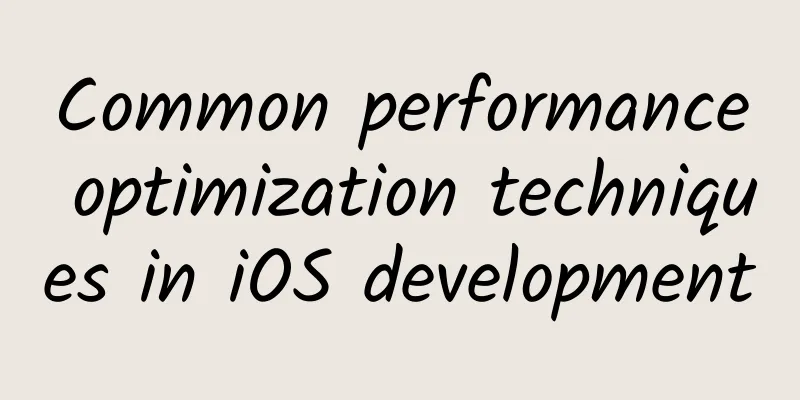Common performance optimization techniques in iOS development

|
What are the main causes of performance issues? There are similar and different reasons, but in the final analysis, they are nothing more than memory usage, code efficiency, appropriate strategy logic, code quality, and installation package size.
But from the perspective of user experience, when we put ourselves in the shoes of users and play an app, what do we care about? If we are playing a mobile game, first of all, we don’t want it to crash suddenly, then we don’t want it to be stuck, then we don’t want the power and data consumption to be too serious, and finally we want the installation package to be smaller. A simple classification is as follows:
1. Fast Slow application startup and frequent freezes during use greatly affect the user experience and should be avoided as much as possible. There are many scenarios for freezes, which can be divided into four categories: UI drawing, application startup, page jump, and event response. There are many reasons for freezes, but no matter what the reasons and scenarios are, they are ultimately displayed on the device screen to reach the user. In the final analysis, there is a problem with the display. According to the iOS system display principle, the fundamental reasons that affect drawing are as follows:
If drawing takes too long, there are some tools that can help us locate the problem. If the main thread is too busy, you need to pay attention. The main thread's key responsibilities are to handle user interactions, draw pixels on the screen, and load display-related data, so it is particularly important to avoid anything that happens on the main thread so that the application can remain responsive to user operations. In summary, the main thread mainly does the following:
In addition, you should try to avoid putting other processing in the main thread, especially complex data calculations and network requests. 2. Stability The definition of application stability is very broad. There are many reasons that affect stability, such as unreasonable memory usage, incomplete consideration of code exception scenarios, unreasonable code logic, etc., which will affect the stability of the application. The two most common scenarios are: Crash and ANR. These two errors will make the program unusable. The more common solutions are as follows:
3. Province In mobile devices, the importance of battery is self-evident. Without power, nothing can be done. For operating system and device developers, power consumption optimization has never stopped in pursuit of longer standby time. However, for an application, the issue of power usage cannot be ignored, especially for those applications that are classified as "battery killers", which will eventually be uninstalled. Therefore, application developers need to minimize power consumption while meeting their needs. 1.CPU Regardless of whether the user is directly using it or not, the CPU is the main hardware used by the application. When operating in the background and processing push notifications, the application will still consume CPU resources. The more computation an application performs, the more power it consumes. Older devices consume more power to perform the same basic operations. The amount of computation consumed depends on different factors. 2. Network Intelligent network access management can make applications respond faster and help extend battery life. When the network is inaccessible, subsequent network requests should be postponed until the network connection is restored. In addition, high bandwidth consumption operations should be avoided when there is no WiFi connection. For example, video streaming, it is well known that cellular wireless systems (LTE, 4G, 3G, etc.) consume much more power than WiFi signals. The root cause is that LTE devices are based on multiple-input, multiple-output technology and use multiple concurrent signals to maintain LTE links at both ends. Similarly, all cellular data links will scan regularly to find stronger signals. Therefore: we need
We all know that location services consume a lot of power. To calculate coordinates using GPS, you need to determine two pieces of information:
Calculating coordinates will constantly use CPU and GPS hardware resources, so they will quickly consume battery power. So how can we reduce it? 1) Turn off unimportant features Determine when you need to track location changes. Call the startUpdatingLocation method when tracking is needed, and call the stopUpdatingLocation method when tracking is not needed. Location tracking should also be turned off when the app is running in the background or the user is not chatting with others. In other words, location tracking should be turned off when browsing the media library, checking the friend list, or adjusting the app settings. 2) Use the Internet only when necessary In order to improve the efficiency of power usage, iOS always keeps the wireless network closed as much as possible. When an application needs to establish a network connection, iOS will take this opportunity to share the network session with the background application so that some low-priority applications can be processed, such as push notifications, receiving emails, etc. The key is that every time a user establishes a network connection, the network hardware will remain active for a few seconds after the connection is completed. Each concentrated network communication consumes a lot of power. To mitigate this problem, your software needs to use the network sparingly. It should periodically use the network for short bursts, rather than maintaining a constant stream of active data. Only then will the network hardware have a chance to shut down. 4. Screen Screens use a lot of power, and the larger the screen, the more power it uses. Of course, if your app is in the foreground and interacting with the user, it will inevitably use the screen and consume power. Here are some ideas for optimizing screen usage: 1) Animation optimization When the app is in the foreground, use animation. Once the app enters the background, pause the animation immediately. Generally speaking, you can pause or stop the animation by listening to the notification events of UIApplicationWillResignActiveNotification or UIApplicationDIdEnterBackgroundNotification, or you can resume the animation by listening to the notification event of UIApplicationDidBecomeActiveNotification. 2) Video Optimization During video playback, the screen should be kept constant. You can use the idleTimerDisabled property of the UIApplication object to achieve this. Once set to YES, it will prevent the screen from sleeping, thus achieving constant light. Similar to animations, you can release and acquire locks through notifications from the corresponding app. Users always carry their mobile phones with them, so it is particularly important to write power-saving code. After all, mobile power banks are not available everywhere. When the complexity of the task cannot be reduced, providing a solution that is sensitive to the battery level and prompting the user at the appropriate time will give the user a good user experience. 4. Small The size of the application installation package has no effect on the use of the application, but the larger the application installation package, the higher the threshold for users to download it. Especially in the case of mobile networks, users have higher requirements for the size of the installation package when downloading applications. Therefore, reducing the size of the installation package can make more users willing to download and experience the product. Of course, although slimming down and reducing the burden are good, we need to pay attention to the impact of slimming down on the maintainability of the project. It is recommended to select techniques based on your own project. The App installation package consists of two parts: resources and executable files. The installation package is slimmed down and optimized from the following three parts. Resource optimization:
Compilation optimization:
Executable file optimization:
Reducing the size of iOS installation packages is something that many medium and large APPs have to do. Generally, they will start with resource files, compress images/audio, and remove unnecessary resources. After these resource optimizations are completed, we can also try to slim down the executable files. The larger the project, the larger the volume occupied by the executable file. Because the AppStore will encrypt the executable file, the compression rate of the executable file is low. After compression, the executable file accounts for about 80%~90% of the volume of the entire APP installation package, which is still worth optimizing. Here are some common optimization solutions: TableViewCell Reuse In the cellForRowAtIndexPath: callback, only the instance is created, the cell is returned quickly, and the data is not bound. In willDisplayCell: forRowAtIndexPath:, the data is bound (assigned). Height Cache When the tableView is sliding, heightForRowAtIndexPath: is called continuously. When the cell height needs to be adaptive, the height needs to be calculated every time the callback is called, which will cause the UI to freeze. In order to avoid repeated meaningless calculations, the height needs to be cached. How to cache?
Don't use JPEG images, use PNG images. The child thread pre-decodes (Decode), and the main thread renders directly. Because when the image is not decoded, directly assigning it to imageView will perform a Decode operation. Optimize the image size and try not to dynamically scale it (contentMode). Whenever possible, combine multiple images into one for display.
Reduce transparent views Using transparent views will cause blending. In iOS graphics processing, blending mainly refers to the calculation of mixed pixel colors. The most intuitive example is that when we stack two layers together, if the first layer is transparent, the final pixel color calculation needs to take the second layer into account. This process is called blending. Reasons that can cause blending: UIView has alpha < 1. The image of UIImageView contains an alpha channel (even if the alpha of UIImageView is 1, as long as the image contains a transparent channel, it will still cause blending).
Why does blending cause performance loss? The reason is very intuitive. If a layer is opaque, the system can directly display the color of the layer. If the layer is transparent, it will cause more calculations because the other layer needs to be included in the mixed color calculation. Setting opaque to YES reduces performance overhead since the GPU will not do any compositing but simply copy from this layer.
Reduce off-screen rendering Off-screen rendering means that the image needs to be rendered once before it is drawn to the current screen. In OpenGL, GPU screen rendering has the following two modes: On-Screen Rendering refers to the current screen rendering, which means that the GPU rendering operation is performed in the screen buffer currently used for display. Off-Screen Rendering is off-screen rendering, which means that the GPU opens a new buffer outside the current screen buffer for rendering operations.
summary Performance optimization cannot be solved by updating one or two versions. It is a continuous demand, continuous integration and iterative feedback. In actual projects, at the beginning of the project, due to manpower and project completion time constraints, the priority of performance optimization is relatively low. When the project enters the commissioning stage, the priority needs to be increased. However, in the early stage of the project, when designing the architecture plan, performance optimization points also need to be considered in advance, which reflects a programmer's technical skills. When there is a need for performance optimization, it usually starts with discovering the problem, then analyzing the cause and background of the problem, and then looking for the best solution, and finally solving the problem. This is also a processing method often used in daily work. |
>>: To all Android engineers: The trouble of not having technical depth
Recommend
How much does it cost to join the Chifeng Hotel Mini Program? What is the price for joining Chifeng Hotel Mini Program?
Why join the WeChat Mini Program Development Comp...
Ocean Love Story Series | Ashi's Old Grave Together: Childhood sweethearts, living together till death
01 Holding hands with you, growing old together A...
Pinduoduo’s paid membership model and operational ideas!
Everyone is familiar with the gameplay of paid me...
November 2023 "Science" Rumors List: Can you change the medicine for treating mycoplasma pneumonia yourself? Is skim milk healthier?
1. You can change the medicine by yourself for th...
LeTV pioneered the concept of smart TV ecosystem: Blindly following the trend will not work
In order to seize the entrance to smart TVs, major...
3 interactive skills for novices to avoid dull moments in live streaming, essential tips for live streaming
Live streaming selling means chatting with custom...
Advertising strategies of Xiaohongshu and Bilibili
Without further ado, let’s get straight to the po...
Why doesn't it rain diamonds on Earth?
Recently, a US scientific research team inferred ...
Apple insider reveals: The new MacBook Pro is a product of compromise
After the new MacBook Pro was launched, it was pl...
2019 China KOL Marketing Strategy White Paper!
Recently, iResearch Consulting and IMS New Media ...
How can online education retain traffic?
As an observer of the education and training indu...
Can the mind also catch a cold? And it’s quite serious!!!
Audit expert: Li Xianhong National Level 2 Psycho...
How to add fans on Kuaishou? Is there any platform to increase Kuaishou fans?
Professional Douyin and Kuaishou likes-boosting p...
What exactly is brand planning planning?
The term brand planning has now become a popular ...
Short video marketing, save these strategies quickly!
In recent years, with the sharp increase in deman...





![[In-depth Revelation] Analysis of Internet Financial Product Operation Strategies!](/upload/images/67cc3b334ca71.webp)



